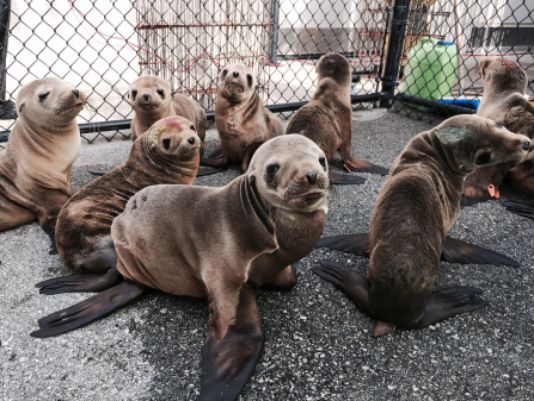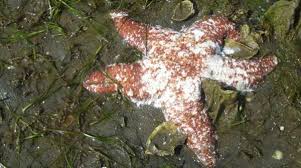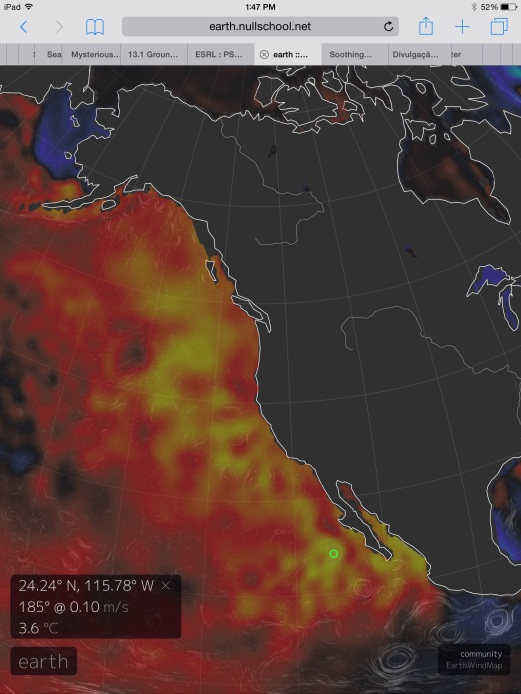What the video below, and Robertscribblers article, reveals is that our Pacific is dying.
The scientists say they have “no idea” of why there has been a large die-off of sea lions and other creatures in the North Pacific. Generally, the pattern is to underestimate the scale of the problem and to see each problem as something isolated and unrelated to anything else.
Thankfully, there are people who do make a sincere effort to tell the truth. However, some of the strongest voices revealing the extent of the Fukushima catastrophe are the most terrible climate change deniers.
Some of the people who are telling us about climate change (lite) – usually liberals – completely ignore Fukushima and pretend it doesn’t exist.
This is all reductionist thinking (which pervades western and ‘scientific’ thought) run rampant.
The truth is that the Pacific is being killed by radiation continually flowing into the Pacific. This die-off is 3 years old and there has been no el-Ninos in that time.
But I’ve got some other news. Read Robertscribbler's article, look at the temperature anomoly maps and you will see that the Pacific is way warmer than ‘normal’ and is storing heat from the effects of anthropogenic global warming.
We have acidification of the ocean, massive plastic pollution, overfishing and ….(what have I left out)?
If you are looking for a single cause for the rapid death ot the Pacific then you could put it down to one – human overshoot and the catastrophic effects of ‘infinite growth’ in a world carrying 7+ billion human beings.
I commend the video below, but ask that people look at what is being revealed in the context of all the evidence.
Watch and mourn for all the wonderful biodivesity of our once wondrous Pacific Ocean
Watch and mourn for all the wonderful biodivesity of our once wondrous Pacific Ocean
Starving
Sea Lion Pups and Liquified Starfish — How We’ve Turned the
Eastern Pacific into A Death Trap for Marine Species
27
February, 2015
As
of late January, the news reports were coming in hot and heavy. Baby
sea lions were dying in droves. More than 15,000 of the pups were
already lost due to starvation. And with each passing week, more than
100 of the emaciated, beleaguered, hopeless animals were washing up
on California shores.
The
pups staggered across beaches, wandered into vacant lots, or
tottered, disoriented, along roadways. Refugees all to some
unspeakable disaster. Orphans lost or abandoned by parents unable to
provide them with even the most basic of sustenance.
(Starving sea lion pups taken in by the Marine Mammal Center in San Francisco. Image source: WTSP.)
Marine
rescue centers, volunteer centers, and even animal shelters were
inundated by a flood of desperate, dying animals. Their organs were
shutting down. They could barely breathe or walk. The future
generation of the more than 300,000 sea lions living along the US
West Coast taking a severe blow from a deadly killer lurking in West
Coast waters.
By
late February more than 1000 sea lion pups had flooded the California
Marine Mammal Center. Hundreds more found their way into local and
ad-hoc shelters. The number was so great that all support systems for
the animals were overwhelmed. Persons finding and seeking help for
the dying pups were, more often than not, turned away due to lack of
support and rescue resources.
It
was like the scene out of some heart-wrenching sci-fi disaster movie.
And everyone kept asking the same question — what could cause this?
Mass
Sea Lion Deaths for Three Years Running
This
most recent spate of sea lion pup deaths and strandings comes after
years of the same. News media currently reports the event in
isolation — as if 2015 were the only year for such a thing to
happen. But the truth is that this crisis has been ongoing now since
at least 2013, with an earlier episode in 2009-2010 preceding the
current chain of related events.
The
2013 event was so severe that in the end 70 percent of the 50,000 sea
lion pups born that year had died. The 2014 event was rather less
severe, accounting for ‘only’ twice the normal loss rate. But
2015 has so far been so deadly that even 2013’s staggering number
of sea lion pup losses could be exceeded.
The
multi-year event represents such a heavy blow to sea lions that
marine organizations have declared the entire current young
generation under threat of being wiped out.
Adult
Sea Lions, Otters, Starfish, Birds and other Marine Creatures
Involved
But
the story doesn’t stop at young sea lion deaths alone. From May
through August of last summer, reports were flooding in of mass adult
sea lion, otter, and bird deaths due to what appeared to be exposure
to some form of toxin.
The
animals would wash up on the beach or drop out of the sky. They would
show signs of convulsions. Autopsies of the deceased animals revealed
shrunken hippocampus, brain and heart lesions.
The
same marine mammal center that is now taking in over 1,000 baby sea
lion pups this summer took in 751 adults suffering from these signs
of toxic poisoning. Simply put, the adults died this past summer and
now the pups are starving.
Further
down the food chain, creatures living in bottom water zones were also
suffering and dying. Fishermen off Oregon had to go further and
further afield to fill nets. Near shore fishing lines came up empty
except for crabs scurrying up the lines as if in an attempt to escape
from danger below.
And
in 2013, thousands upon thousands of starfish began to turn to white
clumps. A freakish instance of mass star fish death that continued
inexorably through 2015.
(A victim of Sea Star Wasting Syndrome. Image source: Crosscut.)
The
star fish would succumb to a strange wasting illness. An illness that
would ultimately waste whole swaths of multiple starfish species (20
separate starfish species and millions of animals are now thought to
be involved). Entire regions saw their starfish populations dwindle
to zero. As with the mass sea lion deaths, marine researchers were
both stunned and befuddled.
Perhaps
even more disturbing is that the various species deaths just keep on
coming — with no apparent end in sight.
A
Hothouse Serial Killer
Just
off shore, a warm wind runs from south to north over the increasingly
wasted waters. Warm airs born of warm waters, providing us with clues
for the cause of this ongoing mass death event. For the seas off the
US West Coast have reached record levels of warmth — a level of
ocean surface heat that flared with the most recent El Nino in 2009
and 2010. A warming that has been building steadily ever since
mortality events began their incessant march in 2013.
(Sea surface temperature anomaly map for February 27, 2015 depicting very large swath of much warmer than average sea surface temperatures running along the West Coast of North America through to the Bering Sea. Such widespread surface warming contributes to numerous detrimental changes to ocean health. Image source: Earth Nullschool. Data Source: Global Forecast System Model.)
Now
a broad swath of surface water ranging from 2-5 C above average
blankets an entire oceanic zone from Alaska to Mexico.
Such
excess heat may seem innocuous at first blush. A little extra warm
water may seem pleasant to the casual observer. But what seems
pleasant actually conceals a deadly threat.
Warm
surface waters spreading over the ocean can serve as a kind of lid.
The warm water prevents cooler water from upwelling toward the
surface, mixing nutrients and refreshing the water’s oxygen levels.
This shut down of overturning is a dangerous oceanic condition called
stratification. And it can level a severe blow to almost all
creatures along the marine food chain. Plankton become less
productive. Low oxygen zones expand, killing the slow-moving bottom
creatures all while driving the mobile fish to more productive
waters. In the warmer waters, toxic algae blooms become more
prevalent. Harmful microbes, which are culled during influxes of cold
water, thrive and multiply, posing a disease threat to all marine
species. Finally, in the deeper reaches off the coasts of Washington
and Oregon, the already oxygen-poor zones, zones rife with methane
from hydrate venting, begin producing a deadly seep of hydrogen
sulfide gas.
The
living sea has now become a killer. And all it took was a little
extra added heat to lock west coast waters in an expanding zone of
warm water and low oxygen marine mortality.
(The signature of ocean stratification expansion — low oxygen zones. Note the large and expanding region of low oxygen in the Eastern Pacific. For reference, high oxygen is shown in greens, blues and purples, low oxygen shown in oranges, reds and black. Image source: AMOP’s Study of Oxygen Minimum Zones. Image date: 2013.)
As
a result we have the proliferation of the sea star wasting illness.
An illness that would usually be contained by the seasonal influx of
cooler waters. So too do we have instances of sea lion adults
consuming fish, mullusks, and shellfish contaminated with domoic acid
— a toxin produced by algae blooms in warm waters. And lastly, we
have the overall stress on the food chain due to low oxygen and
productivity which has driven sea lion food sources so far off shore
that females are too exhausted after hunting to feed their pups.
More
Dangers to Come
The
recent mortality events mirror ocean warming episodes which caused
similar die-offs at the end of glacial periods. Then, as now, warming
robbed waters of oxygen and productive mixing, causing stress to
numerous species.
However,
the current pace of human warming is much more rapid than the warming
periods that occurred at the ends of the ice ages. In addition, under
business as usual human carbon emissions, the deadly, low-oxygen
ocean zones are expected to expand, eventually covering the majority
of the world ocean system. It’s a transition to a stratified ocean
that will make the current west-coast die-off look like a minor
prelude by comparison.
(Hydrogen sulfide eruption off Namibian coast on February 15, 2015. In Namibia, anoxic bottom waters host hydrogen sulfide producing bacteria. Runoff rich with organic material feeds these bacteria as they produce more toxic hydrogen sulfide gas. During upwelling events, the hydrogen sulfide is brought to the surface where it is visible as a florescent green or black slick. Under stratified and Canfield Oceans, more and more regions are capable of supporting deadly hydrogen sulfide production. Currently, the Baltic Sea, Offshore Namibia, the Chesapeake Bay, and Offshore Oregon are known to host broad regions of hydrogen sulfide producing bacteria in anoxic dead zones. Only in Nambia do these zones occasionally reach the surface waters, so far. Image source: Earth Observatory/NASA.)
Eventually,
if CO2e levels exceed 800-1000 parts per million, a transition to an
even more deadly state called a Canfield Ocean is increasingly
likely. And a Canfield Ocean is a powerful killing machine.
Implicated all the previous hothouse extinctions, this killer, during
the Permian Extinction, was likely primarily responsible for the
deaths of 95 percent of species in the ocean and 70 percent of
species on land. For the oceans eventually filled up with deadly
toxins (primarily in the form of hydrogen sulfide gas) which then
vented into the atmosphere.
It’s
a very deadly ocean state we want to avoid at all costs. And we
should view these very troubling instances of ocean species mortality
along the North American West Coast as a warning to stop warming to
oceans as swiftly as possible.
Links:
Hat
Tips:
Colorado
Bob
Leif Thurston
Fukushima Fallout WORLDWIDE
The
Tibetan Plateau is registering more radiation than during the nuclear
bomb test in the 1960's.
Fish
testing at 124 times over radiation limit caught off Fukushima
Fish
with deadly levels of radioactive cesium have been caught just off
the coast of Fukushima prefecture, as scientists continue to assess
the damage caused to the marine food chain by the 2011 nuclear
disaster.
RT,
15
January, 2015
One
of the samples of the 37 black sea bream specimens caught some 37
kilometers south of the crippled power plant tested at 12,400
becquerels per kilogram of radioactive cesium, making it 124 times
deadlier than the threshold considered safe for human consumption,
Japan's Fisheries Research Agency announced.
The
samples were caught at the mouth of the Niidagawa river in Iwaki,
Fukushima Prefecture, on November 17. Two other fish caught there
also tested non-safe for human consumption, showing radiations levels
of 426 and 197 becquerels per kilogram. The rest of the fish were
reportedly within safety limits.
Black
sea bream are currently restricted from being fished in Miyagi and
Fukushima prefectures and sold for human consumption, as scientists
from the Fisheries Research Agency say they plan to investigate the
source of the contamination further.
After
the Fukushima disaster, Japan lowered its threshold for cesium levels
in food from 500 becquerels per kg to 100 becquerels per kilo, making
the country’s regulations six times stricter than European Union
standards. The record cesium reading was recorded last year when a
fish caught near the plant carried 740,000 becquerels of cesium per
kilogram.
Professor
Chris Busby from the Scientific Secretary of the European Committee
on Radiation Risk and a member of the UK Department of Health
Committee Examining Radiation Risk for Internal Emitters (CERRIE),
says that despite a high level of radiation in the marine food chain,
Japan so far is the only one dealing with a direct threat.
“The
concentrations of radionuclides, which are going to the Pacific or
have been injected to the Pacific, by the time they get to the US,
and to China and to South East Korea and so on will not be enormously
high,” Busby told Voice of Russia.
Yet
the scientist warned that nuclear contamination of Japan could result
in 400-800 extra cancer cases in Japan in the next fifty years.
“We've
already seen some effects in infant mortality and thyroid cancer in
Japan,” Busby said. “So I think this is just going to get worse.
I think we are going to see a major effect on the general health of
the Japanese population in Northern Japan. There's going to be a
decrease in the birth rate and an increase in the death rate.”
In
the meantime, TEPCO, the operator of the Fukushima nuclear site,
reported radiation levels 8 times government safety guidelines. TEPCO
told press that the predominant reason behind the sharp increase in
radiation at the plant was X-rays coming from storage tanks holding
radioactive water that has been leaking from the Fukushima facility.





No comments:
Post a Comment
Note: only a member of this blog may post a comment.